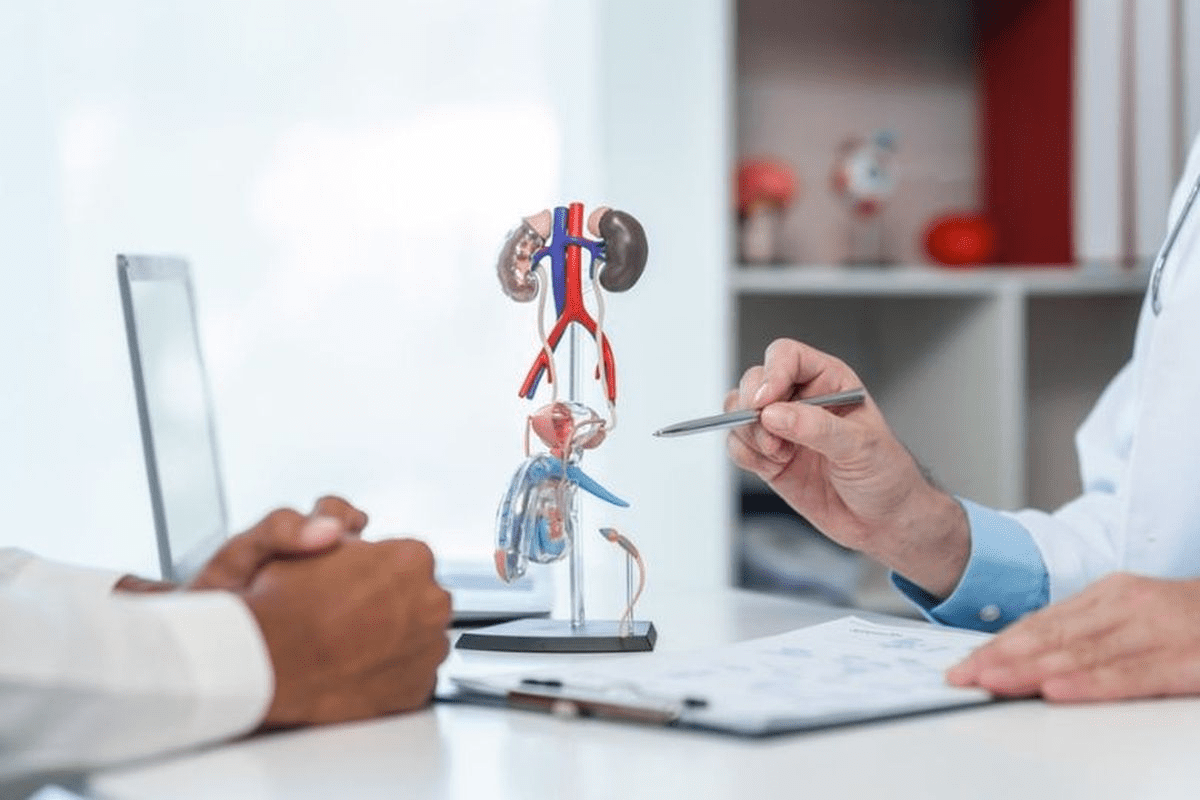Last Updated on November 26, 2025 by Bilal Hasdemir

Managing a biliary drain is key to avoiding problems and helping you heal well. At Liv Hospital, we know how important it is to take care of a biliary drain properly.
Biliary drains are special tubes used when bile can’t flow normally, often due to gallstones or cancer. Knowing how to flush a biliary drain is essential to prevent blockages and infections. Our experts guide patients step-by-step on how to safely and effectively flush their biliary drains.
We want to help you understand how to care for your biliary drain. With our guidance, you can make sure your drain works properly while reducing the risk of complications.
Key Takeaways
- Understand the importance of flushing a biliary drain to prevent blockage and infection.
- Learn the step-by-step process for safe and effective biliary drain flushing.
- Gain confidence in managing your biliary drain care with our expert guidance.
- Reduce the risk of complications with proper biliary drain maintenance.
- Ensure optimal recovery with our patient-focused guidance.
Understanding Biliary Drains and Their Purpose

Biliary drains help restore bile flow in patients with liver and bile duct problems. These devices are key for those with blocked or damaged bile ducts. They ensure bile moves from the liver to the intestine as it should.
What is a Biliary Drainage System?
A biliary drainage system has a tube or catheter in the bile ducts. It helps drain bile. This is important for patients with blocked bile flow due to jaundice or other issues.
Common Reasons for Biliary Drain Placement
Biliary drains are used to clear blockages from gallstones, tumors, or inflammation. Common reasons include:
- Obstructive jaundice
- Bile duct injuries
- Pancreatic cancer
- Cholangiocarcinoma
Types of Biliary Drains and Tubes
There are different types of biliary drains, like biliary drainage tubes, cholecystostomy tubes, and gallbladder tubes. Each type is used for specific conditions and obstructions.
Why Regular Flushing of Biliary Drains is Essential

Regular flushing of biliary drains is key to avoiding blockages and infections. It keeps the drain open and ensures the patient’s health.
Preventing Blockages and Complications
Blockages in biliary drains can cause serious issues like jaundice and liver damage. Flushing regularly removes debris and stops bile salt buildup.
Maintaining Proper Bile Flow
Bile flow is vital for digestion and absorbing fats and vitamins. Flushing the biliary drain often keeps bile flowing well into the intestine.
Reducing Infection Risk
Infections are a big risk with biliary drains. Flushing regularly cuts down this risk by removing bacteria and contaminants. Using the right flushing technique is important to avoid introducing bacteria.
| Benefits of Regular Flushing | Description |
| Prevents Blockages | Removes debris and prevents bile salt buildup |
| Maintains Bile Flow | Ensures bile flows freely into the intestine |
| Reduces Infection Risk | Removes bacteria and contaminants from the drain |
Materials Needed for Flushing a Biliary Drain
Flushing a biliary drain needs more than just the right tools. It also requires a clean and safe area. A well-prepared workspace is key to avoid infections and make sure the procedure works.
Essential Supplies Checklist
First, gather these important items:
- Sterile saline solution for flushing
- A syringe (usually 10-20 mL) for injecting the saline
- Gloves to maintain sterility
- A clean drape or towel to create a sterile workspace
- Antiseptic wipes for cleaning the drain site
Creating a Clean Workspace
Setting up a clean area is vital. Spread a clean drape or towel on a stable surface for your supplies. Make sure the area is bright and free from distractions.
Optional Supplies for Enhanced Safety
For extra safety, consider these:
- A biohazard bag for disposing of waste
- Additional antiseptic solution
- A dressing or bandage in case of leakage
“Proper technique for flushing a biliary drain includes using clean hands and sterile saline,” highlights the need for sterility during the process.
Preparation Steps Before Flushing
Getting ready for biliary drain flushing is key to a safe and successful process. Before we start flushing, we must follow important preparation steps.
Hand Hygiene Protocol
Proper hand hygiene is essential before flushing. Wash your hands well with soap and water or use an alcohol-based hand sanitizer. This step helps prevent infections.
Organizing Your Supplies
Collect all needed supplies before starting. This includes sterile saline solution, syringes, gloves, and any other necessary equipment. Having everything ready makes the process smoother and more efficient.
Patient Positioning and Comfort
Make sure the patient is comfortable and in the right position. This improves their experience and helps with the flushing. A well-positioned patient also lowers the risk of problems.
| Supply | Purpose |
| Sterile Saline Solution | For flushing the biliary drain |
| Syringes | For injecting saline into the drain |
| Gloves | For maintaining sterility |
How to Flush a Biliary Drain: Standard Procedure
To keep a biliary drain working right, it’s key to know how to flush it. Flushing the drain is a vital task. It keeps the drain open and avoids problems.
Accessing the Drain Port Safely
The first thing to do is to safely get to the drain port. Make sure the area is clean. Wear sterile gloves to avoid infection.
Precautions: Always wash your hands before touching the drain. Use sterile tools to avoid contamination.
Syringe Preparation and Handling
Getting the syringe ready is important. We use a sterile syringe filled with saline solution for flushing.
- Draw the saline solution into the syringe under sterile conditions.
- Check the syringe for any air bubbles before proceeding.
- Attach the syringe to the drain port securely.
Gentle Saline Injection Method
The gentle saline injection method helps flush the drain without hurting the tissue. We inject the saline slowly and gently to remove blockages.
| Step | Description |
| 1 | Inject saline solution slowly |
| 2 | Monitor for resistance or blockages |
| 3 | Aspirate gently to check for patency |
Monitoring During the Procedure
Watching the patient during the flush is key for their comfort and safety. We watch for any signs of trouble.
By sticking to these steps and focusing on the patient, we can flush the biliary drain safely and effectively.
Flushing a Biliary Drain with a Stopcock
Knowing how to flush a biliary drain with a stopcock is key. The stopcock controls the flow of fluids through the drain.
Understanding the Stopcock Mechanism
A stopcock is a valve that manages fluid flow. For a biliary drain, it lets doctors control the saline solution flow during flushing. It’s important to handle the stopcock correctly to avoid problems.
Step-by-Step Flushing Procedure
To flush a biliary drain with a stopcock, follow these steps:
- First, make sure the stopcock is turned off to the patient to stop bile flow.
- Next, connect a syringe filled with saline solution to the stopcock.
- Open the stopcock to the syringe and slowly inject the saline.
- Watch for any resistance or blockages during the injection.
- After flushing, turn the stopcock back to its original position.
Common Stopcock Issues and Solutions
Sometimes, stopcock problems like hard to turn or leak can happen. Regular checks and maintenance can prevent these issues. If the stopcock is stuck, don’t force it. Instead, get help from a healthcare professional.
By following these steps, patients and caregivers can manage biliary drain flushing with a stopcock well. This keeps the drain working right and lowers the chance of complications.
How to Flush a Biliary Drain Without a Stopcock
Flushing a biliary drain without a stopcock needs careful planning and different approaches. For those without this device, keeping the drain open and working is key.
Alternative Access Methods
Without a stopcock, doctors must find other ways to clean the biliary drain. They often go straight to the drain catheter. Direct access methods need careful handling to avoid problems.
Safety Considerations for Direct Access
Direct access to a biliary drain must be safe. Strict aseptic technique is vital to lower infection risks. Doctors should wear sterile gloves and use clean tools for the task.
| Safety Measure | Purpose |
| Sterile Gloves | Prevent Infection |
| Sterile Equipment | Maintain Asepsis |
Modified Flushing Technique
When there’s no stopcock, the flushing method changes. It involves slowly adding saline into the catheter while watching for any issues.
Knowing these different methods and safety steps helps doctors manage biliary drains without stopcocks. This ensures patient safety and keeps the drain working well.
Flushing Specific Types of Biliary Drains
Different biliary drains need special flushing methods for best results and patient comfort. These drains vary in form, each for specific medical needs. Knowing their unique features is key for effective flushing and upkeep.
Cholecystostomy Tube Flushing Technique
A cholecystostomy tube drains the gallbladder, often for those with acute cholecystitis who can’t have surgery. Flushing this tube needs a gentle touch to avoid harm or pain. We suggest a 10-20 mL sterile saline flush to keep the tube open and bile flowing.
Gallbladder Drain Flushing Procedure
Gallbladder drains are like cholecystostomy tubes but for different situations. The flushing method involves accessing the drain port with a syringe of sterile saline. Gently inject the solution to remove blockages. Always watch the patient’s reaction and adjust the flush as needed.
Bile Catheter with Drainage Bag Maintenance
Bile catheters with drainage bags need regular flushing to stop clots and keep bile flowing. We recommend flushing with sterile saline every 4-6 hours or as the doctor says. Empty the drainage bag often, and note the bile’s volume and quality for monitoring.
| Type of Biliary Drain | Flushing Technique | Frequency |
| Cholecystostomy Tube | Gentle saline flush | Every 4-6 hours |
| Gallbladder Drain | Syringe with sterile saline | As directed by healthcare provider |
| Bile Catheter with Drainage Bag | Sterile saline flush | Every 4-6 hours |
Biliary Drain Dressing Change Procedure
Keeping the dressing around your biliary drain clean is important for a smooth recovery. It helps prevent infections and skin problems. Changing the dressing regularly is key to keeping it clean.
When to Change Dressings
Change the dressing every 24 to 48 hours, or as your doctor tells you. If it gets wet, dirty, or falls off, change it right away. This keeps the area clean and free from germs.
Step-by-Step Dressing Change Process
To change the dressing, follow these steps:
- Wash your hands well with soap and water.
- Carefully remove the old dressing, avoiding the insertion site.
- Clean the skin with a saline solution or as your doctor advises.
- Let the area dry or gently pat it with a clean gauze.
- Put on a new sterile dressing, making sure it’s snug but not too tight.
Skin Care Around the Insertion Site
Good skin care is vital to avoid irritation and infection. Watch for redness, swelling, or discharge around the insertion site. If you see anything odd, call your doctor right away.
By following these steps and keeping things clean, you can lower the risk of problems with your biliary drain care.
Troubleshooting Common Biliary Drain Problems
Troubleshooting is key in biliary drain care. It helps fix problems early to avoid bigger issues. It makes sure the drain works right, keeping infections and other problems away.
Addressing Resistance During Flushing
Meeting resistance while flushing might mean a block or kink. Try adjusting the tube’s position or use a smaller syringe for less force. If it doesn’t work, contact a healthcare provider for help.
Managing Leakage Issues
Leakage can happen for many reasons, like a bad dressing or infection. Make sure the dressing is tight and dry. Check for infection signs. If leakage won’t stop, talk to a healthcare professional for advice.
When to Contact Healthcare Providers
Knowing when to get medical help is important. Call your doctor if you have ongoing pain, fever, big leaks, or if the drain comes out. As one expert says, “Quick medical help can stop small problems from getting big.” (
Early action is vital for handling biliary drain problems well.
Long-Term Care and Maintenance of Biliary Drains
Proper care of biliary drains is key to keeping patients healthy. It helps avoid complications. We will discuss important practices for long-term care.
Establishing a Regular Flushing Schedule
Having a regular flushing schedule is vital. Regular flushing stops blockages and keeps bile flowing right. Flush the drain as your doctor tells you, usually every day.
Daily Inspection Protocol
Checking the drain daily is important. Look for leaks, blockages, or infections. Careful observation can catch problems early.
Record Keeping for Drain Care
Keeping detailed records is essential. Include flushing schedules and inspection findings. This helps doctors adjust care plans as needed.
Conclusion
Proper care and maintenance of a biliary drain are key to avoiding complications and ensuring a smooth recovery. By following the steps in this guide, you can keep bile flowing well and lower the risk of infection.
Effective biliary drain care includes regular flushing, changing dressings, and watching for any issues. We’ve given you a detailed guide to help you with these tasks confidently. Knowing how to care for your biliary drain can help prevent blockages and other problems.
Remember, taking good care of your biliary drain is a big part of your treatment plan. By staying informed and proactive, you can get the best results and stay healthy. For more details on biliary drain care and maintenance, talk to your healthcare provider or a medical expert.
FAQ
What is a biliary drain, and why is it used?
A biliary drain is a special tube used when bile flow is blocked. This usually happens because of gallstones or cancer. It helps restore bile flow into the intestine.
How often should I flush my biliary drain?
Flushing frequency depends on your doctor’s instructions. Usually, you should flush it daily or as directed. This helps prevent blockages and infections.
What supplies are needed to flush a biliary drain?
You’ll need sterile saline solution, a syringe, and a clean workspace. You might also use gloves and a dressing kit for safety.
How do I access the drain port safely?
First, wash your hands properly. Then, find the stopcock or access port. If there’s a stopcock, turn it right to allow flushing.
What should I do if I encounter resistance during flushing?
If you meet resistance, don’t push the saline solution. Stop and call your doctor. Resistance could mean a blockage or problem.
How do I care for the skin around the biliary drain insertion site?
Keep the skin clean and dry. During dressing changes, check for irritation or infection. Clean with mild soap and water.
Can I shower or bathe with a biliary drain?
It’s best to avoid water until it heals. You can shower with a waterproof dressing. Always follow your doctor’s advice.
How do I flush a cholecystostomy tube?
Flushing a cholecystostomy tube is similar to other biliary drains. Use sterile saline solution and a syringe. Follow your doctor’s specific guidance.
What are the signs of infection or complications with a biliary drain?
Watch for fever, redness, swelling, leakage, or flushing trouble. If you see these signs, call your doctor right away.
How do I manage leakage around the biliary drain site?
Check the drain and dressing for issues. Make sure the drain is secure. If leakage doesn’t stop, call your doctor.
Why is record keeping important for biliary drain care?
Keeping records helps track flushing, notes issues, and monitors health. This info is useful for your doctor during follow-ups.
References
- Han, S., & Kim, M. (2019). Management of postoperative bile leaks using percutaneous biliary drainage. Korean Journal of Radiology, 20(9), 1352–1362. https://pmc.ncbi.nlm.nih.gov/articles/PMC6743098






